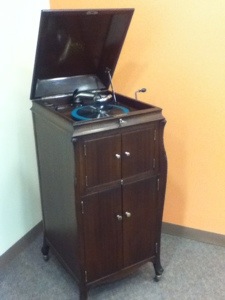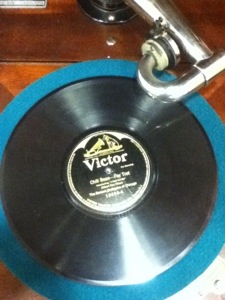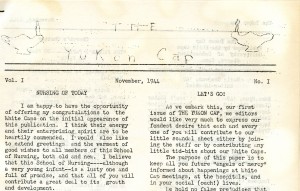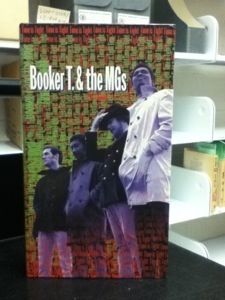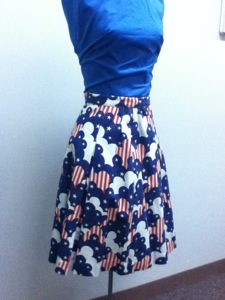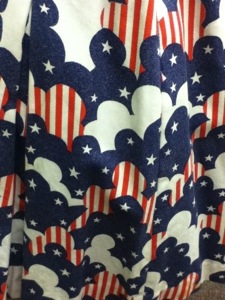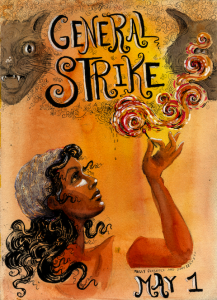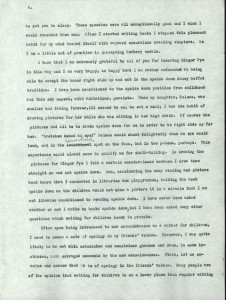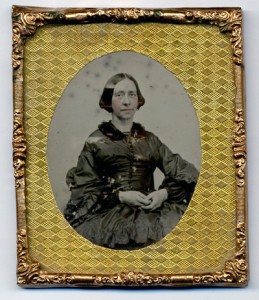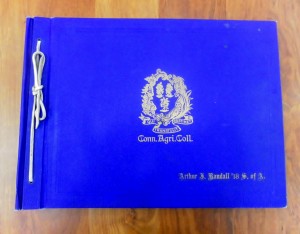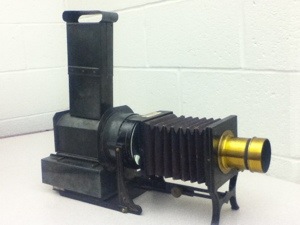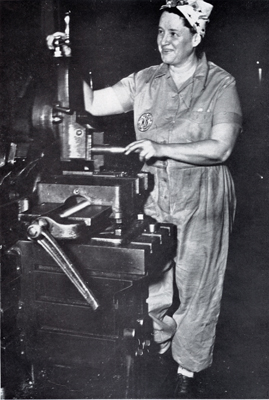Victrola VV XIV, 1917. From the Charters Archives
The UConn White Caps
The School of Nursing at the University of Connecticut was established in 1942 and accredited the following year. The first students received their caps in 1944, an event commemorated in a scrapbook created by the “White Caps,” the nursing student club. The capping ceremony took place on the evening of October 12, 1944 at the Community House situated near the Storrs Congregational Church. Dr. Albert Jorgensen provided the welcome and Dean Carolyn Widmer spoke, reminding “the girls to keep up high ideals in their future years of nursing. Mrs. Widmer then capped each girl, after which Miss Dolan, assistant to Mrs. Widmer, lit each girl’s Florence Nightingale candle. The newly capped girls then took the Cadet Nurses’ Pledge, as all are entering the Cadet Nurse Corps.” [Connecticut Campus, October 1944] The members of the first class in the University of Connecticut School of Nursing included Rhoda Grodin, Marijane Johnson, Selma Mag, Marilyn Olsen, Barbara Payne, Anne Pickett, Elaine Raymond, Shirlee Weinberg and Ann Winchester.
In November 2012, the University opened the Carolyn Widmer Wing of Storrs Hall, the long time home of the School of Nursing. Named in honor of the first Dean of the School, the wing “provides nursing students with a learning environment tailored to the special needs of nursing education and practice” (UConn Today, 11/5/12) underscoring the University’s ongoing commitment to the education and training of nurses symbolized in the capping ceremony so many years ago.
The White Caps’ scrapbook is part of the School of Nursing Records in the University Archives.
Caught My Eye Today
Fifty Years of Anti-Nuclear Power Advocacy: Now Open for Research
During a long career of anti-nuclear power advocacy, from the late 1950s to the early 1990s, Larry Bogart—and his associates after him—gathered together and distributed an enormous collection of information on the hazards of nuclear power. Today the archive serves as a chronicle of the struggle against nuclear power and its grass roots origins. The collection is comprised of 42 boxes, amounting to approximately 54 linear feet, and covers approximately 50 years of time, spanning even after Larry Bogart’s death in 1991. In its extent it is more than a life’s work, and now, after a period of about three months of careful work, I am glad to report is completely inventoried!
The collection is comprised of anti-nuclear power publications from many different nationwide organizations—including his own, such as Nuclear Opponents and Energy News Digest—which show his concern for the nationwide problem, rather than merely local concerns. As can be surmised from the vast quantity of newspaper clippings, though, he devoted much attention to stopping power plants in the Northeast, such as Indian Point in New York, Vermont Yankee, and Seabrook in New Hampshire. His correspondence, though rarer, further indicates a deep devotion to the fight against nuclear power—since it is very nearly the only subject discussed—and correspondence written to him at his various organizations such as the Citizens Energy Council, Friends of the Hudson and the Anti-Pollution League—often requests for information or subscriptions to publications—shows his great importance within this advocacy movement.
The Larry Bogart Papers, rather than a direct biography of Larry Bogart, provides students and researchers with ample source materials for studying the movement as well as the specific concerns of scientists and citizens in the early era of nuclear power. Larry Bogart brought countless clippings and publications into one place from people and organizations from around the world, giving us a collection with a very wide scope. What the collection offers is greater than one person could have produced singlehandedly: a chronicle of fifty years of anti-nuclear advocacy, told in many voices.
Daniel Allie, undergraduate student employee
Caught My Eye Today
#Occuprint
One of our recent acquisitions is a poster collection created by Occuprint of the Occupy Wall Street Screen Printing Guild. The collection consists of thirty-one posters which were selected from hundreds on the Occuprint website. The materials were produced under creative commons allowing for free copying and usage as well as open submission by artists illustrating the occupy movement world wide. These logos and images are now finding their way onto t-shirts, buttons, flyers and websites. The prints began as sketches and signage made on pizza boxes in Zuccotti Park, New York during the Occupy Wall Street encampment which evolved into the polished and colorful images printed by the guild. Demonstration art and signage is not an original artifact of the Occupy movement, as our Poras Collection of Vietnam War Memorabilia demonstrates; infact the modern poster is often reliant on the influences of previous counter culture and purposefully self-aware. However, this material is a representation of demonstration sign art which was never part of the demonstration itself, thereby creating a digital archive of art in a political vein originating across the globe to both mimic the Occupy Wall Street movement and symbolize the individual geographies of protest. Its appeal for mass reproducibility, as occured in previous eras of resistance and demonstration, is in itself a form of protest to the commodification of art as an industry for profit, a root cause of “the 99%” slogan.
These posters can be viewed by appointment only, please contact the curator of the Alternative Press Collection for details. A great resource of digitized demonstration posters from the 1960s and 1970s can be found at the Oakland Museum of California.
Insight on a Fellowship
Glastonbury, Conn., English teacher David Polochanin was recently awarded the James Marshall Fellowship, as he pursues to write young adult literature as part of a yearlong sabbatical. During his research, he will write an occasional series of blog posts, based on his observations and insights relating to the contents of the Northeast Children’s Literature Collection at the University of Connecticut. This is the second in the series.
Blog post 2: On The Psychology Of Writing
“You may think that this is the first Newbery acceptance speech I have ever made. But it isn’t. Long ago, before I ever wrote a book, when I was a children’s librarian and first aware of the Newbery Medal, I used to often put myself to sleep at night making speeches accepting this coveted award. These speeches were all exceptionally good and I wish I could remember them now. After I started writing, I stopped this pleasant habit, for my mind busied itself with wayward excursions creating chapters for… books.”
Excerpt from Eleanor Estes’ 1952 Newbery Medal speech for her book Ginger Pye
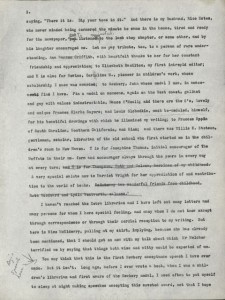
Within the publishing industry, there is a genre subset that exists mainly because of the uncertainty, mystery, and pressure that all writers face – the self-help writing guide. New books are sold every year, offering expert advice on such writerly, often impossible, things as how to summon the muses, where characters come from, the best ways to begin and end a story, if outlining is necessary for everyone, as if these were insider secrets only known to a few. Still, we learn that some authors write early in morning; others late at night. Some claim the best ideas come while taking long walks; others write what they dream and form stories around that.
To prove the marketability of such books, there is still a shelf at your local Barnes and Noble and the UConn Co-op reserved for such titles as John Gardner’s The Art of Fiction, Ray Bradbury’s Zen In The Art Of Writing, Stephen King’s On Writing: A Memoir Of The Craft, Natalie Goldberg’s Writing Down the Bones: Freeing The Writer Within, Anne Lamott’s Bird By Bird: Some Instructions on Writing and Life, and Strunk and White’s The Elements of Style, among others.
As a writer, especially at the beginning, during those fledgling phases when you’ve got 40 pages of something and it isn’t going so well, it’s hard not to look at these books. They are indeed tempting to read. Teachers at the college level routinely assign them as class texts, and the content is often useful, if not entertaining. I’ve bought a bunch of them myself, and every now and then, I return to them for inspiration or direction.
So, what makes me bring up the self-help industry for writers? A progressive-minded document from 1952.
Browsing through the Eleanor Estes papers recently I came upon several drafts of her Newbery Medal speech, given in 1952 for her book Ginger Pye, which stopped me in my tracks. As I read the draft, complete with cross-outs and edits, I stopped at the excerpt at the top of this post and had to reread it. I copied it verbatim on my yellow legal pad. Estes, a former librarian in New York City, said this was not her first speech. She had given many of them, in her head, putting herself to sleep at night imagining that she had won the award. What she was saying could have easily been included in a how-to-write guide; it still could.
With so much written about the psychology of writing – directly or indirectly – the truth remains elusive. What works for some will not work for all. I know for a fact that I do not have the motivation to write at 4:30 a.m., as some writers do. My most productive work time is sometime between 10 a.m. and 2 p.m. It used to be from 9 p.m. to midnight, before my kids entered the picture. I have had numerous ideas come to me while on bike rides and while driving my car, though I would hesitate to say there is a direct correlation between generating writing ideas and movement. Perhaps through doing these activities, my mind has an opportunity to clear out some space for creative thought. But who really knows.
Reading from superior examples in the genre you’re writing seems to help warm up the brain. Perhaps it’s nothing more than mere imitation. But is this scientifically based? I doubt it, or know if it can be. Still, Ted Kooser, the Pulitzer Prize winning poet who has been the U.S. Poet Laureate, in interviews says he has done this, as have many other writers. When I was a journalist at the Providence Journal, before a major assignment an editor once sent me a handful of front-page feature stories from the Wall Street Journal before I started to write one of my own. I did “channel” something from those stories, but I think I was too young to figure out how the articles she sent could help me.
Nevertheless, I guess the Estes comment surprised me because of the time period in which she wrote it, and also because it still makes so much sense today. How could it not help to imagine doing the very thing you want to do? Isn’t visualization/imagery the most primitive version of positive psychology? Estes was priming her brain to write great works, and her nightly fantasizing ritual ultimately gave her a tight focus and, quite likely, a motivation.
It worked for her. Could it work for others?
Sifting through boxes of manuscripts in the Northeast Children’s Literature Collection, I suppose, can have a similar effect: to gain a psychological edge in the writing process. It’s easy to forget sometimes that writing is truly an art form, and that artists need inspiration and particular conditions in order to do it well. Whether it’s writing near the window at Starbucks, which seems to be a favorite for many, or in a secluded study room at a library, I’m not sure if there are any big secrets that will work for everyone. The trick, I think, is discovering what will work for you.
Insights on a Fellowship
Glastonbury, Conn., English teacher David Polochanin was recently awarded the James Marshall Fellowship, as he pursues to write young adult literature as part of a yearlong sabbatical. During his research, he will write an occasional series of blog posts, based on his observations and insights relating to the contents of the Northeast Children’s Literature Collection at the University of Connecticut. This is the second in the series.
Blog post 2: On The Psychology Of Writing
“You may think that this is the first Newbery acceptance speech I have ever made. But it isn’t. Long ago, before I ever wrote a book, when I was a children’s librarian and first aware of the Newbery Medal, I used to often put myself to sleep at night making speeches accepting this coveted award. These speeches were all exceptionally good and I wish I could remember them now. After I started writing, I stopped this pleasant habit, for my mind busied itself with wayward excursions creating chapters for… books.”
Excerpt from Eleanor Estes’ 1952 Newbery Medal speech for her book Ginger Pye

Within the publishing industry, there is a genre subset that exists mainly because of the uncertainty, mystery, and pressure that all writers face – the self-help writing guide. New books are sold every year, offering expert advice on such writerly, often impossible, things as how to summon the muses, where characters come from, the best ways to begin and end a story, if outlining is necessary for everyone, as if these were insider secrets only known to a few. Still, we learn that some authors write early in morning; others late at night. Some claim the best ideas come while taking long walks; others write what they dream and form stories around that.
To prove the marketability of such books, there is still a shelf at your local Barnes and Noble and the UConn Co-op reserved for such titles as John Gardner’s The Art of Fiction, Ray Bradbury’s Zen In The Art Of Writing, Stephen King’s On Writing: A Memoir Of The Craft, Natalie Goldberg’s Writing Down the Bones: Freeing The Writer Within, Anne Lamott’s Bird By Bird: Some Instructions on Writing and Life, and Strunk and White’s The Elements of Style, among others.
As a writer, especially at the beginning, during those fledgling phases when you’ve got 40 pages of something and it isn’t going so well, it’s hard not to look at these books. They are indeed tempting to read. Teachers at the college level routinely assign them as class texts, and the content is often useful, if not entertaining. I’ve bought a bunch of them myself, and every now and then, I return to them for inspiration or direction.
So, what makes me bring up the self-help industry for writers? A progressive-minded document from 1952.
Browsing through the Eleanor Estes papers recently I came upon several drafts of her Newbery Medal speech, given in 1952 for her book Ginger Pye, which stopped me in my tracks. As I read the draft, complete with cross-outs and edits, I stopped at the excerpt at the top of this post and had to reread it. I copied it verbatim on my yellow legal pad. Estes, a former librarian in New York City, said this was not her first speech. She had given many of them, in her head, putting herself to sleep at night imagining that she had won the award. What she was saying could have easily been included in a how-to-write guide; it still could.
With so much written about the psychology of writing – directly or indirectly – the truth remains elusive. What works for some will not work for all. I know for a fact that I do not have the motivation to write at 4:30 a.m., as some writers do. My most productive work time is sometime between 10 a.m. and 2 p.m. It used to be from 9 p.m. to midnight, before my kids entered the picture. I have had numerous ideas come to me while on bike rides and while driving my car, though I would hesitate to say there is a direct correlation between generating writing ideas and movement. Perhaps through doing these activities, my mind has an opportunity to clear out some space for creative thought. But who really knows.
Reading from superior examples in the genre you’re writing seems to help warm up the brain. Perhaps it’s nothing more than mere imitation. But is this scientifically based? I doubt it, or know if it can be. Still, Ted Kooser, the Pulitzer Prize winning poet who has been the U.S. Poet Laureate, in interviews says he has done this, as have many other writers. When I was a journalist at the Providence Journal, before a major assignment an editor once sent me a handful of front-page feature stories from the Wall Street Journal before I started to write one of my own. I did “channel” something from those stories, but I think I was too young to figure out how the articles she sent could help me.
Nevertheless, I guess the Estes comment surprised me because of the time period in which she wrote it, and also because it still makes so much sense today. How could it not help to imagine doing the very thing you want to do? Isn’t visualization/imagery the most primitive version of positive psychology? Estes was priming her brain to write great works, and her nightly fantasizing ritual ultimately gave her a tight focus and, quite likely, a motivation.
It worked for her. Could it work for others?
Sifting through boxes of manuscripts in the Northeast Children’s Literature Collection, I suppose, can have a similar effect: to gain a psychological edge in the writing process. It’s easy to forget sometimes that writing is truly an art form, and that artists need inspiration and particular conditions in order to do it well. Whether it’s writing near the window at Starbucks, which seems to be a favorite for many, or in a secluded study room at a library, I’m not sure if there are any big secrets that will work for everyone. The trick, I think, is discovering what will work for you.
Caught My Eye Today
Through the Lens of an Anthropologist: Scrapbooking Our University Roots
Carey MacDonald is an undergraduate Anthropology major and writing intern. In her blog series Through the Lens of an Anthropologist, Carey analyzes artifacts found in the collections of Archives and Special Collections.
Although college customs tend to change over time, their social ramifications remain profound and everlasting. We are able to observe these traditions and their impact on students from such artifacts as documents, photographs, or, in this case, from scrapbooks.
The University Scrapbook Collection contains the scrapbook of one Arthur J. Randall who was a student at Connecticut Agricultural College from 1916 to 1918 when Charles L. Beach (of Beach Hall) was the college’s president. Randall’s scrapbook reflects his two years at C.A.C. in stunning detail and provides great insight into his personal college experience. Needless to say, this scrapbook also outlines C.A.C.’s very own history and traditions and highlights the agricultural roots of what is now the University of Connecticut.
Arthur J. Randall’s scrapbook is a wide, bound, bright blue book that was printed by The College Memory Book Company of Chicago, IL and copyrighted in 1914. It is called the “Memory and Fellowship Book” and is dedicated to the “Keepers of Keepsakes” in its inside title page. The Latin phrase “Qui Transtulit Sustinet,” or “He Who Transplanted Still Sustains,” is featured in gold on the front cover below a gold emblem. This same phrase is found on the Connecticut state seal, according to CT.gov. “Conn. Agri. Coll.” and Arthur’s full name and graduating year of 1918 are etched below the emblem. Also interestingly, the inside backing of the book shows the seals of several other American universities that must have also contracted out to The College Memory Book Company of Chicago. Ultimately, the scrapbook’s elaborate imagery and design are indicative of the significance of collegiate history and tradition.
Moreover, Randall’s scrapbook includes such things as class registration cards, treasurer’s cards, boarding and dining cards, Athletic Association season tickets, post office box renting fee slips, and other miscellaneous charge slips. He also kept many photographs of various buildings on campus, Horsebarn Hill, and his friends.
His scrapbook is, in essence, a repository of rather mundane items – but items that are nonetheless useful for our purposes. We can glean from Randall’s collection that he was likely a typical, responsible, self-aware student, by today’s standards at least, as well as by the standards of his time.
Also interesting is Randall’s account of the campus goings-on. First, he marks September 12, 1916 as “the beginning of my career” in the calendar section of his scrapbook. His “Comparative Athletic Record” shows that he played recreational basketball on several occasions. He notes the President’s Reception and Rope Pull – two traditional university events –in October of 1917, as well as the Halloween Masquerade, Benefit Dance for the Red Cross, and “first moving pictures” in November of the same year.
Randall also takes note of the fire that burned down the old chemistry building on the morning of November 27, 1917. This major change in the university setting was certainly upsetting, hence his note that it was a “total loss.” Essentially, in the academic year of 1917-18 Randall took note of many of the events he attended, which also included going to church services and Mansfield Grange meetings on a regular basis. It is particularly interesting that he recorded the events of his second year more than his first, and perhaps this is because he felt inclined to preserve what was left of his college career.
Lastly, Randall even held onto many of his final exams, the likes of which he also discusses in his calendar notes. By writing on January 21, 1918 about midyear exams that “to think of the next five days is enough to make you crazy,” Randall implies that the university view on exams was much like it is today: exams are stressful and throw everyone into a collective state of turmoil. His class schedules included classes such as Veterinary Science, Agriculture, Farm Management, Animal Husbandry (which he deemed ‘killer’), Dairy Husbandry, Horticulture, Forestry, History, and, interestingly, Military Drill and Military Science.
Randall’s records further identify the founding of the University of Connecticut as an agricultural school, and his apparent interest in recording exactly that indicates his pride in and appreciation for the school. It is from these roots that our university grew and diversified into the flagship research university that it is today.
Carey MacDonald, writing intern
Caught My Eye Today
Photographs from Archives & Special Collections part of an exhibit at the National World War II Museum in New Orleans
Several months ago I worked with Laura Blum, a student at E.O. Smith High School in Mansfield, Connecticut, who needed photographs from the Connecticut Business History Collections for a project she was working on for the National World War II Museum in New Orleans. Laura was selected, with fifty other high school students in every state in the country and the District of Columbia, to provide images of how their states contributed to the challenges of World War II on the homefront. Laura chose six photographs from our collections, all depicting Connecticut workers and the efforts they made on behalf of the war effort, and wrote an introduction.
The photographs that Laura chose are available in the Connecticut window of the Salute to Freedom website of the National World War II Museum, at http://salutetofreedom.org/. We are happy that Laura used photographs from our collection for this national-oriented project and very impressed with the good work she did in highlighting and describing the photographs.
The museum blogged about the exhibit on December 31, 2012, available here: http://www.nww2m.com/2012/12/student-scholars-honor-local-contributions-to-wwii/


